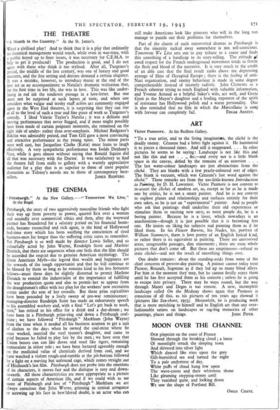ART
Victor Pasmore. At the Redfern Gallery.
"To a true artist, and to the living imagination, the cliché is the deadly enemy. Cezanne had a bitter fight against it. He hammered it to pieces a thousand times. And still it reappeared. . . In other pictures he seems to be saying : Landscape is not like this and not like this and not . . &c.—and every not is a little blank space in the canvas, defied by the remains of an assertion . The last water-colour landscapes are just abstractions from the cliché. They are blanks with a few pearly-coloured sort of edges. The blank is vacuum, which was Cezanne's last word against the cliché." These remarks are from the too-little-known Introduction to Painting, by D. H. Lawrence. Victor Pasmore is not content to re-assort the cliches of modern art, so, except as far as he is made one by critics, he is not a smart painter. And he is not content to explore planes and relationships and surfaces entirely for their own sakes, so he is not an " experimental " painter. And to people who ask that paintings shall underline their old experiences or stimulate them to exciting new ones, as most people do, he is a boring painter. Because he is a lover, which nowadays is an anachronism—though it is just possible that it is becoming less one. He insists on liking his subjects and painting them as if .he liked them. In his Flower Barrow, his Nudes, his, portrait of William Stammers, there is love poetry of an English lyrical k nd, or rather there is its equivalent in painting. There are unresolved areas, unagreeable passages, dim statements ; there are even whole pictures that don't come off. But these are emptinesses—refusal to state clichés—and not the result of smoothing things over.
One doubt• remains: about the standing-aside from some of the chief concerns of present-day painting. A painter cannot today treat Picasso, Rouault, Segonzac as if they led up so many blind alleys. For him at the moment they may, but he cannot finally reject them until he has first accepted them as his concern ; unless he is going to escape into privacy. There may be ways round, but the way through Manet and Degas is too remote. A new, incomplete landscape called On the Medway shows again that Pasmore is conscious of all this. as his pictures of ten years ago showed it (pictures like Sea-shore, 1933). Meanwhile, he is producing work that is more enriching to himself and to English art than any over- fashionable satires on landscapes or rag-bag memories of other


























 Previous page
Previous page